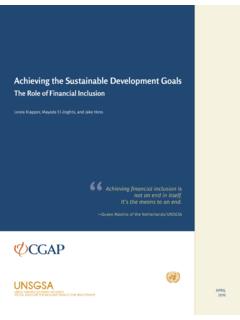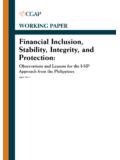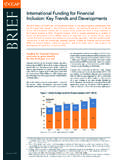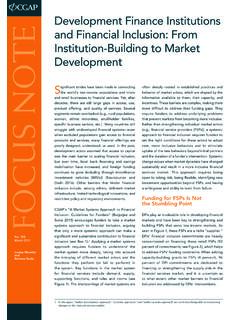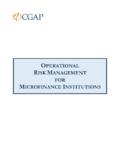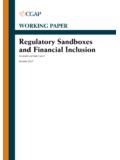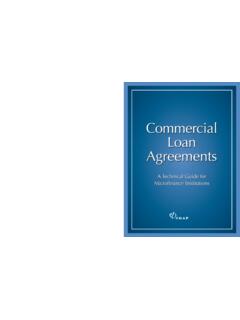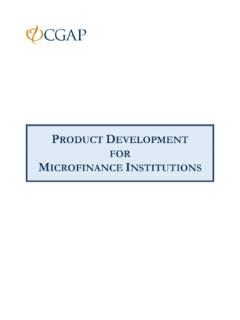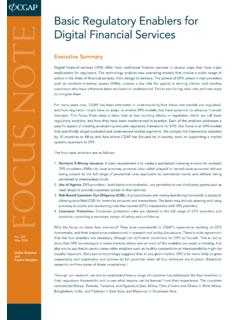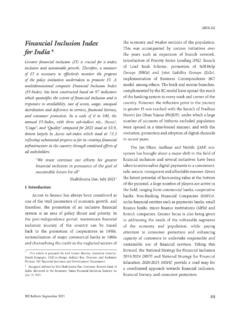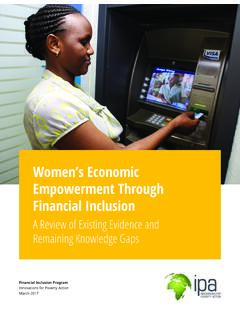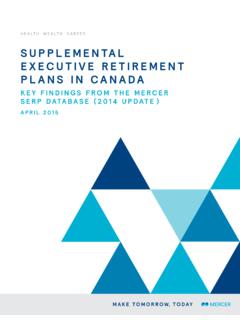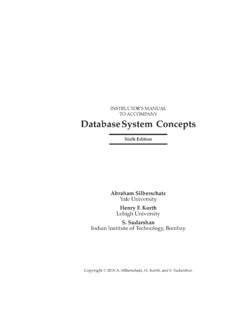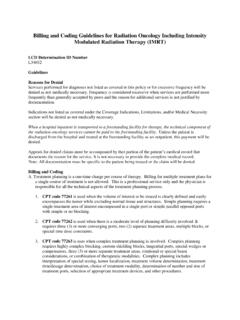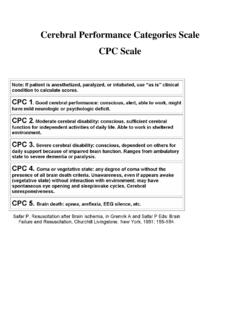Transcription of CREDIT SCORING IN FINANCIAL INCLUSION - CGAP
1 CREDIT SCORING . IN FINANCIAL . INCLUSION . How to use advanced analytics to build CREDIT - SCORING models that increase access July 2019 Maria Fernandez Vidal and Fernando Barbon 1. Consultative Group to Assist the Poor 1818 H Street NW, MSN F3K-306. Washington DC 20433. Internet: Email: Telephone: +1 202 473 9594. Cover photo by Sujan Sarkar, India. CGAP/World Bank, 2019. RIGHTS AND PERMISSIONS. This work is available under the Creative Commons Attribution International Public License ( ). Under the Creative Commons Attribution license, you are free to copy, distribute, transmit, and adapt this work, including for commercial purposes, under the following conditions: Attribution Cite the work as follows: Vidal, Maria Fernandez, and Fernando Barbon. 2019. CREDIT SCORING in FINANCIAL INCLUSION . Technical Guide. Washington, : CGAP. Translations If you create a translation of this work, add the following disclaimer along with the attribution: This translation was not created by CGAP/World Bank and should not be considered an official translation.
2 CGAP/World Bank shall not be liable for any content or error in this translation. Adaptations If you create an adaptation of this work, please add the following disclaimer along with the attribution: This is an adaptation of an original work by CGAP/World Bank. Views and opinions expressed in the adaptation are the sole responsibility of the author or authors of the adaptation and are not endorsed by CGAP/World Bank. All queries on rights and licenses should be addressed to CGAP Publications, 1818 H Street, NW, MSN IS7-700, Washington, DC 20433 USA; e-mail: CONTENTS. Executive Summary 1. Introduction 3. Benefits of CREDIT SCORING 4. Section 1: Data for Automated CREDIT SCORING 7. Section 2: Setting up a CREDIT SCORING Project 10. Section 3: Preparing the Project Data Set 18. Section 4: SCORING Model Development 23. Section 5: Evaluating a SCORING Model 29. Section 6: How to Use the SCORING Model 32. Section 7: Advans C te d'Ivoire Case Study 34. Section 8: Final Lessons 37.
3 References 39. Appendix 40. E XECUTIVE SUMMARY. S. TAT IS T IC A L MODE L S C A N H E L P L E N DE R S I N E M E RGI NG. markets standardize and improve their lending decisions. These models define customer SCORING based on a statistical analysis of past borrowers' characteristics instead of using judgmental rules. Evidence shows that statistical models improve the accuracy of CREDIT decisions and make lending more cost-efficient. They also help companies make key decisions throughout the customer lifecycle. Lenders sometimes assume that statistical CREDIT SCORING is too costly or difficult or that they do not have the kind of data needed to implement it. However, the primary input needed for this type of modelling is something many providers already possess: customers' repayment histories. This guide explains what types of data lenders can leverage for statistical CREDIT SCORING and the ways in which it can be used. Furthermore, different statistical models can be used for building CREDIT scores.
4 Lenders who are new to data analytics can start with a simple model and tailor it over time to meet their needs. In this guide, readers will find a step-by-step approach to building, testing, fine- tuning, and applying a statistical model for lending decisions based on a company's growth goals and risk appetite. This guide emphasizes that the effectiveness of data analytics approaches often involves building a broader data-driven corporate culture. E x ec u t i v e S umm a r y 1. INTRODUCTION. T. H IS IS A S T E P-BY- S T E P GU I DE TO This Guide addresses the following: the methodologies, processes, and data that How CREDIT SCORING works. FINANCIAL services providers can use to develop new CREDIT SCORING models. It is particularly relevant for markets Benefits of data-driven CREDIT SCORING methodologies. that have limited CREDIT bureau coverage and for providers How to use data analysis in different scenarios, depending on who want to target customers who are traditionally excluded access to data and data quality.
5 From formal CREDIT . The Guide will show you how to How to deploy a CREDIT SCORING project and the resources and conduct a SCORING model project with limited external data processes needed. and will provide real-life insights about opportunities and potential pitfalls from experience in the field. The Guide Commonly used analytical techniques. applies statistical theory to real CREDIT SCORING situations. 1. How to use the data produced to create new and better CREDIT Besides providers, others who work in FINANCIAL services products. would find this Guide to be useful. These include loan The Guide concludes with an illustrative case study of a officers, risk managers, and data scientists. Chief FINANCIAL microfinance organization. officers and chief executive officers can use this Guide to help them make decisions about a new loan product or lending process reform. The Guide is written from the perspective of a project manager because project managers often need to ensure that the business side of a company understands the technical and statistical work and that technical staff understand the company's business needs.
6 The techniques described here are meant to help organizations become more efficient and effective in providing FINANCIAL services to their customers. They offer a simple, yet effective, CREDIT SCORING methodology and guidance around processes and decisions, including the knowledge, skills, tools, and data sources, needed when developing and deploying a new CREDIT SCORING project using internal and some limited external data sources. 1 See Anderson (2007) for more information. In t rod u c t ion 3. BENEFITS OF CREDIT SCORING . C. R E DI T S C OR I NG C A N H E L P Statistical SCORING , on the other hand, relies on quantified FINANCIAL institutions grow their portfolios by characteristics of the prospect's portfolio history recorded in lowering the cost of serving low-income customers a database . It uses a set of rules and statistical techniques to and increasing the quality of service and customer forecast risk as a probability. satisfaction. The two approaches complement each other and bring A CREDIT SCORING model is a risk management tool that assesses different benefits and challenges, as shown in Table 1.
7 In the CREDIT worthiness of a loan applicant by estimating her this Guide, SCORING refers to statistical SCORING . probability of default based on historical data. It uses numerical Statistical SCORING models are: tools to rank order cases using data integrated into a single value that attempts to measure risk or CREDIT worthiness. Empirical. Based on a rigorous statistical analysis that derives empirical ways to distinguish between more and less The decision-making process for CREDIT SCORING can be either creditworthy consumers using data from applicants within a subjective or statistical (Schreiner 2003). reasonable preceding period. Subjective SCORING relies on the input of an expert, the loan Statistically valid. Developed and validated based on officer, and the organization to produce a qualitative judgment. generally accepted statistical practices and methodologies. TABLE 1. Comparison of Subjective and Statistical SCORING Dimension Subjective SCORING Statistical SCORING Source of knowledge Experience of loan officer and organization Quantified portfolio history in database Consistency of process Varies by loan officer and day-to-day Identical loans scored identically Explicitness of process Evaluation guidelines in office; sixth sense/gut Mathematical rules or formulae relate feeling by loan officers in field quantified characteristics to risk Process and product Qualitative classification as loan officer gets to Quantitative probability as scorecard relates know each client as an individual quantitative characteristics to risk Ease of acceptance Already used, known to work well; MIS and Cultural change, not yet known to work well.
8 Evaluation process already in place changes MIS and evaluation process Process of implementation Lengthy training and apprenticeships for loan Lengthy training and follow-up for all officers stakeholders Vulnerability to abuse Personal prejudices, daily moods, or simple Cooked data, not used, underused, or human mistakes overused Flexibility Wide application, as adjusted by intelligent Single application, forecasting new type of risk managers in new context requires new scorecard Knowledge of trade-offs and what Derived from tests with repaid loans used to Based on experience or assumed would have happened construct scorecard Source: Schreiner 2003. CREDIT SC ORING IN FIN A NCI A L INCLUSION 4. Periodically revalidated. Re-evaluated for statistical Reduce cost and time from manual risk assessment soundness from time to time and adjusted, as necessary, to Reduce customer turnaround with fewer in-person maintain or increase its predictive power. interactions These models are especially useful in lending situations where Lower administrative costs per unit the lender must manage a large volume of CREDIT assessments for loan amounts that are relatively low and generally for Lower the number of in-person interactions with retail CREDIT for individuals and small businesses.
9 Prospective borrowers Even though the most common application of CREDIT SCORING Improved accuracy of CREDIT decisions (targeted lending is to assess CREDIT worthiness, FINANCIAL institutions (FIs) also based on default probability). use it to help them make decisions at other stages of their Minimize rejection of creditworthy applicants customers' life cycle. For each stage of the customer life Maximize rejection of high-risk applicants cycle, there is a different SCORING type based on specific data. Figure 1 illustrates this dynamic (CGAP 2016). Establishment of an objective and standardized data-driven decision-making culture An application SCORING model focuses on selecting the borrowers to approve from the applicant pool. Using an Apply base objective and consistent decision making on automated application CREDIT SCORING solution has several empirical evidence benefits, including: Standardize criteria for decision making Operational efficiency gains Minimize room for human error or bias FIGURE 1.
10 The borrowing process customer lifecycle Offer CREDIT line and loan term increases? Cross-sell additional services? PROSPECTING SCORING A P P L I C AT I O N S C O R I N G B E H AV I O R A L / P E R F O R M A N C E S C O R I N G. Addressable Target Applicants: Approved Active Good Repeat Market: Customers: Who applies? Borrowers: Borrowers: Borrowers: Borrowers: Who can you Who do you want Who is approved? How to How to retain Who can reach? to reach and how? manage borrowers reapply for customer who repay new loans? relationships? loans? Accept or Reject? Under what conditions? What loan features to offer? Bad Lost to Borrowers: attrition: Who is Who is at risk written off? of attrition? COLLECTION AT T R I T I O N. SCORING SCORING . Bene f i t s of C r ed i t S c or ing 5. FIGURE 2. Enhance the customer relationship throughout the lifecycle using SCORING models Phase 1 Phase 2 Phase 3 Phase 4. Sustain and manage Risk scores Cross-selling customers' engagement Up-selling models Manage customers'.
